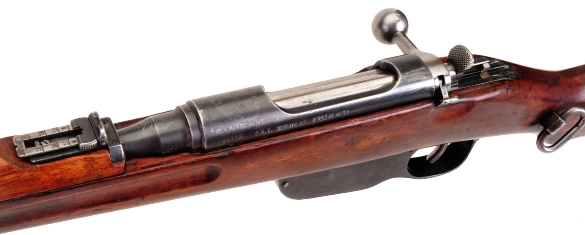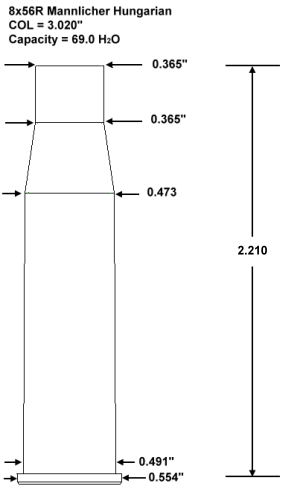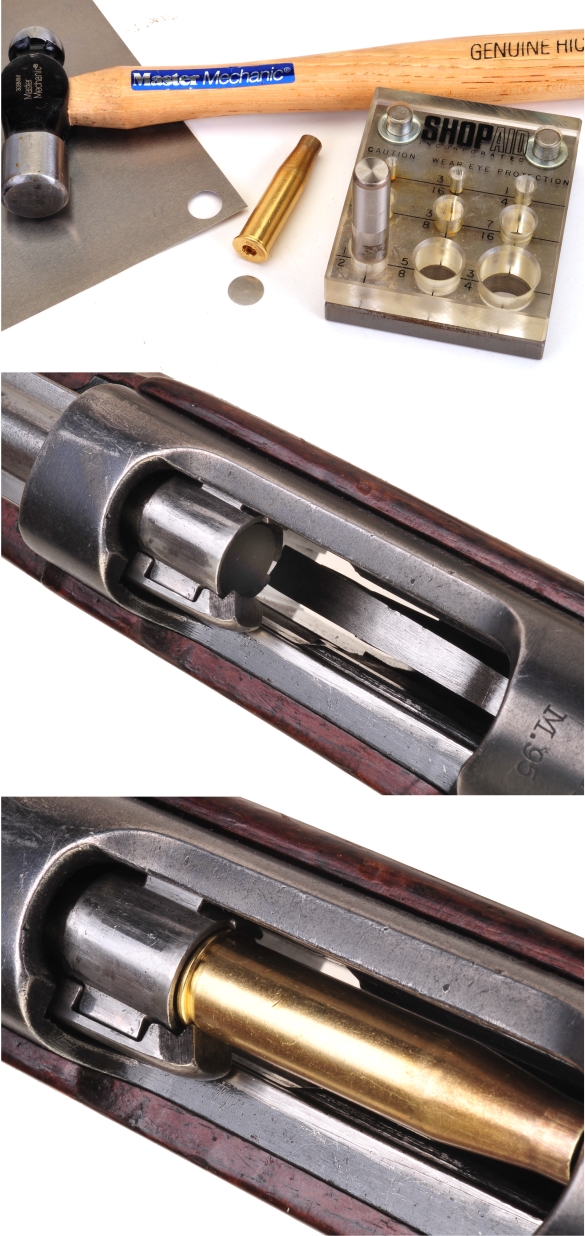The Austrian M.95 Mannlicher cleaned up and slicked up and turned into a terrific seven pound chunk of time worn, blued steel and oil soaked walnut. With so many conflicting and unsubstantiated pieces of information on the internet relative to the M.95’s origins, I decided to pick up a copy of Scarlata’s Mannlicher Military Rifles. The book offered more information, but I am not sure to what end, as there is no author’s bio or statement of credentials; the author is certainly qualified to successfully publish books, I just can’t tell if he is qualified to write them. Information is only of use when the source and the source’s foundation are known.

Descriptions found in Mannlicher Military Rifles suggests that this subject gun is M.95/30 Repetiergewehr und Stutzen, a rifle cut down to carbine length. The front sight is banded, the front stock band has a bottom bayonet lug and stacking rod, the aft band sports only a side sling mount and the sight is Stutzen length. The gun was converted to use the 8mm M.30 scharfe S-Patrone cartridge in 1937. I can therefore conclude, with great confidence, this is an old military rifle that has been patched and recycled numerous times, at numerous locations, and is intact for no historical purpose.
The 8mm M30, AKA the Hungarian Mannlicher
 There are a number of 8x56mm cartridges, such as the 8×56 Mannlicher-Shoenauer, 8x56R Hungarian Mannlicher and 8x56R Kropatchek. With military certification in 1930 as a machine gun cartridge, the 8x56mm is currently referenced in various ways. Prvi labels their ammunition 8×56 RS Mannlicher, Lee Precision labels their dies for this cartridge 8×56 Rimmed Hungarian, QuickLOAD lists it as the 8×56 R M30S, The Handloader’s Manual of Cartridge Conversionsby Donnelly catalogues it as the 8x56R Hungarian Mannlicher, and Cartridges of the World – 12th Edition lists it as the 8x56mm Austrian/Hungarian Mannlicher 8mm Hungarian M31… really. The cartridge has such a distinct 22 Hornet on steroids look, it is pretty easy to identify where illustrated.
There are a number of 8x56mm cartridges, such as the 8×56 Mannlicher-Shoenauer, 8x56R Hungarian Mannlicher and 8x56R Kropatchek. With military certification in 1930 as a machine gun cartridge, the 8x56mm is currently referenced in various ways. Prvi labels their ammunition 8×56 RS Mannlicher, Lee Precision labels their dies for this cartridge 8×56 Rimmed Hungarian, QuickLOAD lists it as the 8×56 R M30S, The Handloader’s Manual of Cartridge Conversionsby Donnelly catalogues it as the 8x56R Hungarian Mannlicher, and Cartridges of the World – 12th Edition lists it as the 8x56mm Austrian/Hungarian Mannlicher 8mm Hungarian M31… really. The cartridge has such a distinct 22 Hornet on steroids look, it is pretty easy to identify where illustrated.
I avoided the M.95 in the past because factory ammunition was either very expensive or not to be found, and there was an absence of 0.329″ bullets and brass of an acceptable quality. Then Graf’s began selling Prvi 208 grain soft point and FMJ ammo, along with inexpensive Prvi brass and both Prvi and Hornady bullets… time to buy the rifle.
The first task was locating some dimensional and pressure reference so the rifle could be checked for headspace and I could work up safe handload data. The information came from RCBSLoad, cross checked with both The Handloader’s Manual of Cartridge Conversions and QuickLoad drawings and validated with physical case measurement.
Extrapolating headspace…
 I was able to check over the general condition of the firearm and determine it was in OK physical condition; no weakness resulting from corrosion, no significant bore pitting, no poorly fitted parts or areas of significant wear. What remained was checking headspace. Initially, there seemed to be a commercially available headspace gauge, until I saw the producer trolling message boards asking participants for their opinion of specification and looking for volunteers to “beta test” his production. Headspace really doesn’t work that way. The dimension is a design specification, a checking standard, associated with a chamber drawing, it isn’t a collaboration or based on a sampling of old firearms.
I was able to check over the general condition of the firearm and determine it was in OK physical condition; no weakness resulting from corrosion, no significant bore pitting, no poorly fitted parts or areas of significant wear. What remained was checking headspace. Initially, there seemed to be a commercially available headspace gauge, until I saw the producer trolling message boards asking participants for their opinion of specification and looking for volunteers to “beta test” his production. Headspace really doesn’t work that way. The dimension is a design specification, a checking standard, associated with a chamber drawing, it isn’t a collaboration or based on a sampling of old firearms.
A drawing check of all rimmed cartridges from the 218 Bee to the 45-70 Government, regardless rim thickness and operating pressure, indicates a rim thickness tolerance of +0.000″/-0.010″ and a headspace tolerance of +0.007″/-0.000″. So the case rim could be as thin as 0.045″, the maximum chamber headspace 0.062″, for a total gap between the case head and bolt face of 0.017″. This would suggest that if I couldn’t close a bolt over a headspace gauge 0.017″ thick the gun should be OK on headspace. I realize this may seem like a crude approach, but, it does follow the norm for rimmed cartridges as defined by a standards organization.
The case rim diameter of the8x56R is 0.554″ in diameter, the bolt face inside it’s rimmed edge is 0.520″. So I broke out the shim punch set and cut two each 0.500″ diameter 0.005″, 0.006″ and 0.007″ thick shims. Then I paired and juggled shims, slipping them into the bolt face and slipping a cartridge case under the gun’s extractor as pictured in the middle frame, until I checked headspace from 0.005″ up through 0.014″ where I was unable to close the bolt. I suppose I could have also used modeling clay on the bolt face; slam the bolt, section and measure the clay, but it’s tough to take a small critical measurement in this manner.

The 8x56R headspaces on the rim, not the shoulder, its long sloping shoulders do not lend themselves to establishing a positive headspace locating point. Headspacing on the shallow shoulder angle would yield wide variations in headspace with even small variations in case sizing. Consequently, a handloader should not attempt to headspace on the shoulder or compensate for headspace by adjusting the sizer die.
Measured performance – factory and handloaded ammo

The 8x56R is not a rocket, but it isn’t a slouch. Its velocity isn’t exciting in context with other military rounds, but it is actually a solid hitter with lots of kinetic energy. Listed left to right:
| Cartridge | Bullet Grains |
Case Grains |
Max PSI |
MV FPS |
ME Ft/Lbs |
| 30-06 Sprgfld | 172 | 68.0 | 58740 | 2640 | 2663 |
| 8x56R | 208 | 70.0 | 51448 | 2395 | 2650 |
| 8x57IS | 226 | 63.0 | 56565 | 2095 | 2203 |
| 7.62x54R | 185 | 64.0 | 56565 | 2660 | 2907 |
| 7.5×55 Swiss | 174 | 65.0 | 55114 | 2560 | 2533 |
Nominal case capacity is listed between 66.0 and 69.0 grain of water, depending on source document. 68.0 grains is consistent with new brass, once fired brass checked 72.2 grains and full length sized to 72.0. That is enough difference to require charge adjustment to accommodate the increased case volume. A charge based on 68.0 grain case, in a 72.0 grain case, yield about 5,000 PSI less pressure and approximately 75 fps less velocity.
Any soft point bullet you want… as long as it’s 205 grains

I was hoping to post a good handload data table, but there just aren’t enough right size bullets for it that address other weights. That said, for a short barrel rifle and wooded deer country, I doubt much more is needed. This is a round where handloading offers a big boost to performance without bumping beyond the round’s 52k PSI ceiling. Prvi ammo is relatively light and puts the round’s ballistics more on par with the 30-30 WCF.
|
Cartridge: 8x56R |
|
| |
|
| |
|
| |
|
| |
|
| COL and Capacity | Load Data & Performance | ||||||||
| Bullet Type | Bullet Weight |
C.O.L. Inches |
Net Grains Water |
Powder | Charge Grains |
Muzzle Velocity FPS |
Muzzle Energy Ft/Lbs |
Group Size” |
|
| Hornady SP | 205 | 3.000 | 61.0 | Re17 | 54.0 | 2286 | 2379 | 2.5 | |
| Hornady SP | 205 | 3.000 | 61.0 | Varget | 51.0 | 2415 | 2655 | 2.8 | |
| Hornady SP | 205 | 3.000 | 61.0 | H414 | 56.0 | 2449 | 2731 | 2.2 | |
| Hornady SP | 205 | 3.000 | 61.0 | RS Hunter | 59.0 | 2482 | 2803 | 3.1 | |
| Prvi Factory | 208 | – | – | – | – | 2079 | 1997 | 2.5 | |
| Groups shot with military metallic sights | |||||||||
The M.95 was well behaved. It barks a bit, a lot like the M38 or M44 Nagant, but not bad. Clearly this combination is up to deer and black bear hunting and it is fast enough handling for hogs close in. The action is slick, feels every bit as good as a K31 without all of the weight and exposed camming surfaces. Scope? Maybe, but not something I would do with this rifle. Bullet weight is a little heavy, a little like hunting with a 35 Remington or 358 Winchester. I might be tempted to cast something lighter, but not in the near future.
Thoughts before eating a barbequed burger…

I need to go on record that the sling for this rifle reminded me of the scent of Milsurp, wet horse. Setting that aside, I like the M.95 a lot. It is an ultralight rifle compared to the K31 straight pull rifle, the cartridge has good ballistics and I’d think the 200 and change grain slugs probably serve the useful applications for this rifle.
The M.95 Mannlicher, Steyr… Austrian, M30… gun has something most Mausers don’t have, lots of personality. I shot the gun for a bit, then looked for excuses, several times, to shoot it some more. Could it be a sporter? Not for me. Too many rigid features that can’t be slicked up. Should it be preserved as a piece of history? Not in my view. These guns are far from original anything and just being old doesn’t make something special – just ask my wife when we’re having a spirited… debate. They are out there being sold for under $150 in very good condition. That’s a fair price for a lot of fun and the procurement of a great truck gun.
Straight Pull Rifles, Hold the Swiss… Part I
The Mannlicher M.95 – Straight Pull Rifle Part II

Email Notification